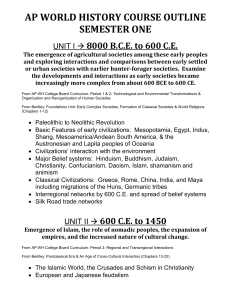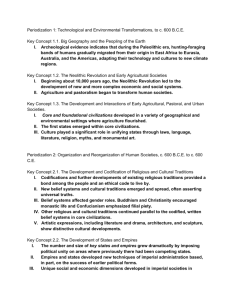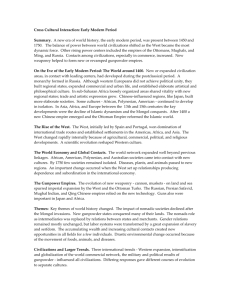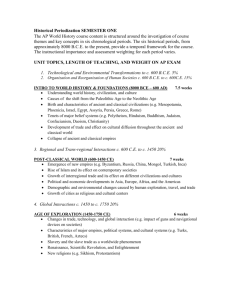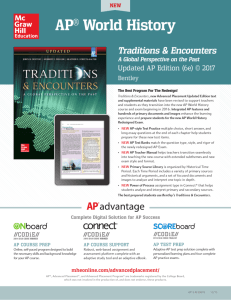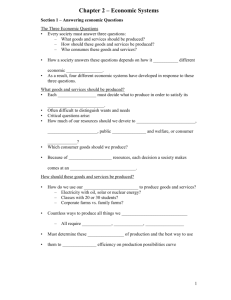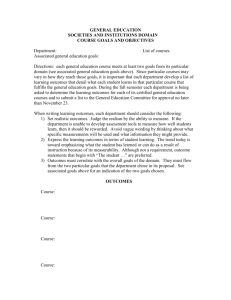midterm review sheet - global history
advertisement
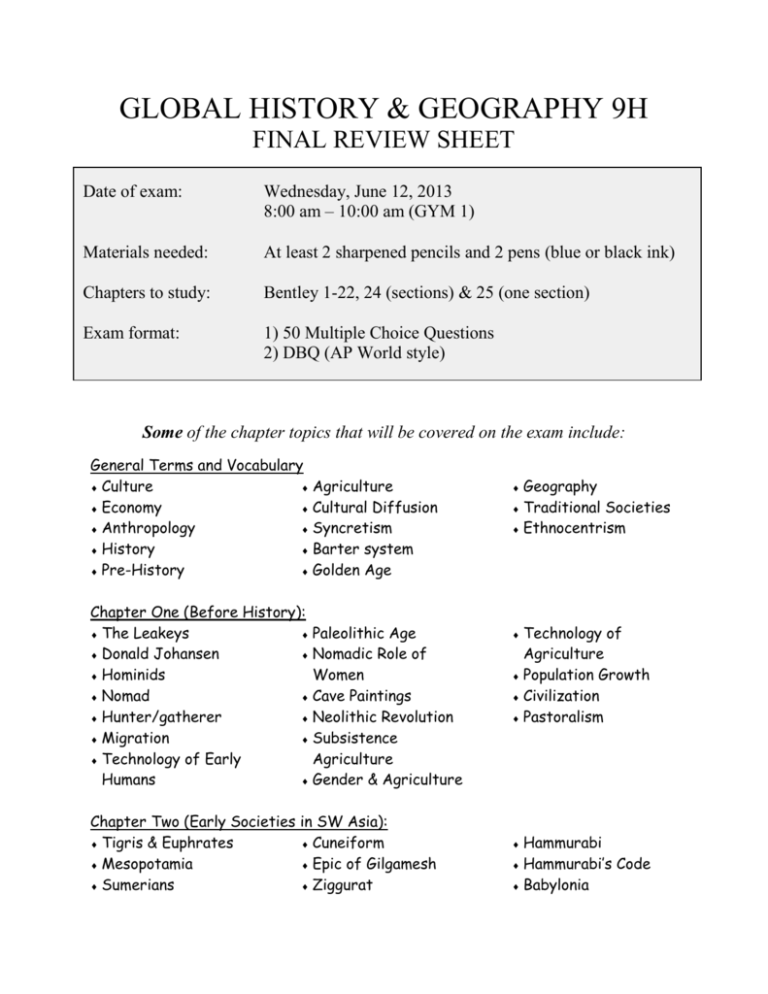
GLOBAL HISTORY & GEOGRAPHY 9H FINAL REVIEW SHEET Date of exam: Wednesday, June 12, 2013 8:00 am – 10:00 am (GYM 1) Materials needed: At least 2 sharpened pencils and 2 pens (blue or black ink) Chapters to study: Bentley 1-22, 24 (sections) & 25 (one section) Exam format: 1) 50 Multiple Choice Questions 2) DBQ (AP World style) Some of the chapter topics that will be covered on the exam include: General Terms and Vocabulary Culture Agriculture Economy Cultural Diffusion Anthropology Syncretism History Barter system Pre-History Golden Age Chapter One (Before History): The Leakeys Paleolithic Age Donald Johansen Nomadic Role of Hominids Women Nomad Cave Paintings Hunter/gatherer Neolithic Revolution Migration Subsistence Technology of Early Agriculture Humans Gender & Agriculture Chapter Two (Early Societies in SW Asia): Tigris & Euphrates Cuneiform Mesopotamia Epic of Gilgamesh Sumerians Ziggurat Geography Traditional Societies Ethnocentrism Technology of Agriculture Population Growth Civilization Pastoralism Hammurabi Hammurabi’s Code Babylonia Assyrians New Babylonians Wheel Trade Networks Patriarchal Role of Women o Veils Hebrews Palestine Diaspora Monotheism Phoenicians Alphabet Chapter Three (Early African Societies): Nile River Pyramids Cataracts Pharaohs Desertification Hieroglyphics Sahel Demotic Ancient Egypt Akhenaton “Gift of the Nile” Cult of Osiris Mummification Nubia Chapter Four (Early Societies in South Asia): Indus River Early Aryan Hindu-Kush Mtns Migration Ganges River Vedas Monsoons Caste & Varna Mohenjo-Daro Subcastes & Jati Harappa Rig Veda Chapter Five (Early Societies in East Asia): Yellow River Iron Metallurgy’s Xia impact Shang Role of merchants Zhou Veneration of Millet ancestors Bronze Metallurgy Patriarchal Decentralized gov’t Oracle Bones Mandate of Heaven Chinese Writing Chapter Six (Early Societies in the Americas & Oceania): Olmecs Ceremonial centers Maize Jade & obsidian Indo-European Migration o Language o Horses o Hittites o Iron Metallurgy o War Chariots Role of Women Meroitic Writing Kush Hyksos Trade Networks Bantu Migration Sati Upanishads Moksha Karma Dharma Brahman Book of Songs Warring States Period Steppe Nomads Yangzi River Terraced farming Yucatan Peninsula Maya Mayan terraced farming Tikal City-kingdoms Chichen Itza Popol Vuh Bloodletting Ball game Maya calendar Maya writing Teotihuacan Pyramids of the Moon & Sun Andes Mtns Chavin Terraced farming Irrigation Alpacas & llamas Mochica Waru waru Chapter Seven (Empires of Persia): Achaemenid Persian Royal Road Cyrus Qanat system Darius Persian Wars Persepolis Seleucid/Parthains/ Satrapies Sasanids Lydian coins Free peasants Chapter Eight (The Unification of China): Confucius Shi Huangdi Analects Book burning Daoism Centralization Laozi The Great Wall st Daodejing 1 Emperor’s Tomb Legalism Standardization Han Feizi Han Qin Liu Bang Australian hunting & gathering societies Austronesian migrations Agriculture in New Guinea Polynesia Lapita peoples Zoroastrianism Ahura Mazda Influence of Zoroastrianism Han Wudi Confucian education Xiongnu Ban Zhao Silk, Paper, Crossbow Yellow Turban Uprising Chapter Nine (State, Society, and the Quest for Salvation in India): Mauryan Dynasty Indian Ocean Trade Siddhartha Ashoka Maurya Epics Gautama Rock & Pillar Edicts Vaisyas Mahayana Buddhism Regional Kingdoms Jainism Bodhisattvas Gupta Dynasty Ahimsa Bhagavad Gita Arabic Numerals Buddhism Popular Hinduism Gupta Golden Age Chapter Ten (Mediterranean Society: The Greek Phase): Minoans Direct Democracy Mycenaean Society Greek colonies City-States (Polis) Mediterranean Sparta Trade Military Society Olympic Games Lycurgus Slavery Athens Socrates, Plato & Solon Aristotle Pericles Pythagoras Parthenon Greek Deities Chapter Eleven (Mediterranean Society: The Roman Phase): Etruscans Octavian/Augustus Roman Republic Pax Romana Law (12 Tables) Roman roads Patricians & Commercial agric. plebeians Meditrn. trade Punic Wars Aqueducts Roman Expansion “Bread & Circus” Julius Caesar Paterfamilias Cult of Dionysus Comedy & Tragedy Persian Wars Delian League Peloponnesian War Philip of Macedon Alexander the Great Hellenistic Slavery Roman Deities Cicero & Stoicism Mithras & Isis cults Judaism Christianity Jesus of Nazareth Paul of Tarsus Chapter Twelve (Cross-Cultural Exchanges on the Silk Roads): Zhang Qian o Christianity Constantine Monsoon System o Manichaeism Germanic Invasions Hellenistic Trade Spread of Disease The Huns Silk Roads Fall of the Han St. Augustine Mare Nostrum Sinicization of Orthodox Spread of… nomads Christianity o Buddhism Fall of W. Rome Patriarchs o Hinduism Diocletian Chapter Thirteen (The Expansive Realm of Islam): Arabian Peninsula Hajj Bedouin The Five Pillars Islamic Golden Age Hijrah/Hegira Expansion & policies Muhammad Mecca/Makkah Quran/Koran Shariah Caliph Umayyad Dynasty Abbasid Dynasty Sunni/Shia Dar al-Islam Spread of new crops Hemispheric trading zone Camels & caravans Al-Andalus Veiling of women Sufis Chapter Fourteen (The Resurgence of Empire in East Asia): Sui Dynasty Fast-Ripening Rice Grand Canal Internal trade Tang Dynasty Population & Li Bo urbanization Xuanzang Foot binding Equal-Field System Porcelain Tributary states Gunpowder Buddhist Influence Block printing & Dunhuang moveable type Chan/Zen Buddhism Naval technology Song Dynasties Paper money Neo-Confucianism Silla Dynasty Chapter Fifteen (India and the Indian Ocean Basin): Mahmud of Ghazni Internal trade Delhi Sultanate Indian Ocean trade Chola Dhows & junks Monsoons & irrigation Emporia advances Specialized Temples as production community centers Axum Chapter Sixteen (The Two World of Christendom): Byzantine The Franks Constantinople Charlemagne Caesaropapism Vikings Justinian & Theodora Heavy plow Justinian Code Feudalism Hagia Sophia Manorialism Mosaic Population decrease & Theme System recovery Byzantine trade Pope Greek fire Patriarch Influences on Islam (Persian, Indian, Greek) Chinese influence on Korea, Vietnam & Japan Nara Japan Heian Japan Shintoism The Tale of Genji Feudal Japan Shogun Samurai Code of Bushido Expansion of the caste system Hindu cults Bhakti Indian influence in SE Asia Angkor Wat Iconoclasm Monasticism Cyril & Methodius Schism Black Sea-Baltic trade Slavs Kiev & Vladimir Onion domes Chapter Seventeen (Nomadic Empires & Eurasian Integration): Nomadic pastoralism o Society Silk Road travel Turks o Conquest o Trade Saljuq/Seljik Turks Mongol impacts o Missionaries o Persia (Abbasid) o Persia o Diplomats o Anatolia (Byzantine) o China (Kublai) o Bubonic plague o India o Russia (Golden Tamer Lane Mongols Horde) Ottoman o Genghis Pax Mongolica Chapter Eighteen (States and Societies of Sub-Saharan Africa): Bananas Camels Swahili Coast Early Africa Ghana o Kilwa & Sofala Kin-based society o Gold & Salt Great Zimbabwe Animism o Islam Axum Slavery Mali Ethiopia Role of women o Mansa Musa o King Lalibela Zanj revolts o Jenne & Timbuktu o Rock churches Chapter Nineteen (The Increasing Influence of Europe): Holy Roman Empire o Urban women William the Meditrn. Trade Conqueror Hanseatic League Agricultural growth Three Estates Development of towns Chivalry & cities Troubadours Early Commercial Rev. St. Thomas Aquinas o Guilds Lay Investiture Chapter Twenty (Worlds Apart: The Americas & Oceania): Maize Inca The Mexica/Aztec o PERSIAN o PERSIAN o Empire o Tribute o Roads/Bridges o Trade o Terraces o Chinampas o Quipu Pueblo/Navajo/ o Trade Iroquois Australian foragers Gothic Religious orders Heresy Vinland Crusades Reconquista Spanish Inquisition (chapter 23) Pacific islanders o Long-distance voyages o Maori & sweet potatoes o Society o Religion Chapter Twenty-one (Reaching Out: Expanding Horizons of Cross-Cultural Interaction): Travelers o Rabban Sauma o Humanism o Marco Polo Exchanges o Machiavelli o Ibn Battuta o Sugarcane Hundred Years War Diplomats o Gunpowder Spain o John of o Plague Ivan the Great Montecorvino Italian city-states Ming Missionaries The Renaissance o Neo-Confucianism o Sufis o Leonardo da Vinci o Zheng He Chapter Twenty-two (Transoceanic Encounters and Global Connections): Portuguese est. of Christopher Columbus Conquest of Java Medit. sugar Ferdinand Magellan Seven Year’s War plantations James Cook Columbian Exchange Caravel Portuguese trading o Impacts on areas Maritime technology posts Environmental Volto do mar Trading Companies impacts of trade Prince Henry the Conquest of the Navigator Philippines Vasco da Gama o Manila Galleons Chapter Twenty-four (The Americas and Oceania): Taino Viceroys Encomienda Las Castas Smallpox Silver Mining Conquistadores Mita o Cortes Hacienda o Pizarro Engenho Council of the Indies Chapter Twenty-five (Africa and the Atlantic World): Portuguese slave Chattel slavery trade The Middle Passage Triangular trade Olaudah Equiano Settler colonies in N. America Fur trade Tobacco Mercantilism Indentured labor Impact of Catholicism African Diaspora 9H Themes (Possible Essay Topics) The AP World History course requires students to engage with the dynamics of continuity and change across the historical periods that are included in the course. Students should be taught to analyze the processes and causes involved in these continuities and changes. In order to do so, students and teachers should focus on FIVE overarching themes which serve throughout the course as unifying threads, helping students to put what is particular about each period or society into a larger framework. The themes also provide ways to make comparisons over time and facilitate cross-period questions. Each theme should receive approximately equal attention over the course of the year. 1. Interaction between humans and the environment Demography and disease Migration Patterns of settlement Technology 2. Development and interaction of cultures Religions Belief systems, philosophies, and ideologies Science and technology The arts and architecture 3. State-building, expansion, and conflict Political structures and forms of governance Empires Nations and nationalism Revolts and revolutions Regional, transregional, and global structures and organizations 4. Creation, expansion, and interaction of economic systems Agricultural and pastoral production Trade and commerce Labor systems Industrialization Capitalism and socialism 5. Development and transformation of social structures Gender roles and relations Family and kinship Racial and ethnic constructions Social and economic classes 9H Habits of Mind The AP World History course addresses habits of mind in two categories: (1) those addressed by any rigorous history course, and (2) those addressed by a world history course. Four habits of mind are in the first category: Constructing and evaluating arguments: using evidence to make plausible arguments Using documents and other primary data: developing the skills necessary to analyze point of view and context, and to understand and interpret information Assessing continuity and change over time and over different world regions Understanding diversity of interpretations through analysis of context, point of view, and frame of reference Five habits of mind are in the second category: Seeing global patterns and processes over time and space while connecting local developments to global ones Comparing within and among societies, including comparing societies' reactions to global processes Considering human commonalities and differences Exploring claims of universal standards in relation to culturally diverse ideas Exploring the persistent relevance of world history to contemporary developments 9H Key Concepts Period 1: Technological and Environmental Transformations, to c. 600 BCE Big Geography and the Peopling of the Earth Archaeological evidence indicates that during the Paleolithic era, hunting-foraging bands of humans gradually migrated from their origin in East Africa to Eurasia, Australia and the Americas, adapting their technology and cultures to new climate regions. The Neolithic Revolution and Early Agricultural Societies Beginning about 10,000 years ago, the Neolithic Revolution led to the development of new and more complex economic and social systems. Agriculture and Pastoralism began to transform human societies. The Development and Interactions of Early Agricultural, Pastoral and Urban Societies Core and foundational civilizations developed in a variety of geographical and environmental settings where agriculture flourished. The first states emerged within core civilizations. Culture played a significant role in unifying states through laws, language, literature, religion, myths and monumental art. Period 2: Organization and Reorganization of Human Societies, c. 600 BCE to 600 CE The Development and Codification of religious and Cultural Traditions Codification and further developments of existing religious traditions provided a bond among the people and an ethical code to live by. New belief systems and cultural traditions emerged and spread, often asserting universal truths. Belief systems affected gender roles (such as Buddhism’s encouragement of a monastic life or Confucianism’s emphasis on filial piety). Other religious and cultural traditions continued parallel to the codified, written belief systems in core civilizations. Artistic expressions, including literature and drama, architecture and sculpture, show distinctive cultural developments. The Development of States and Empires The number and size of imperial societies grew dramatically by imposing political unity on areas where previously there had been competing states. Empires and states developed new techniques of imperial administration based, in part, on the success of earlier political forms. Imperial societies displayed unique social and economic dimensions. The Roman, Han, Maurya, and Gupta empires created political, cultural and administrative difficulties that they could not manage, which eventually led to their decline, collapse and transformation into successor empires or states. Emergence of Transregional Networks of Communication and Exchange Land and water routes created transregional trade, communication and exchange networks in the Eastern Hemisphere, while separate networks connected the peoples and societies of the Americas somewhat later. New technologies facilitated long-distance communication and exchange. Alongside the trade in goods, the exchange of people, technology, religious and cultural beliefs, food crops, domesticated animals and disease pathogens developed across far-flung networks of communication and exchange. Period 3: Regional and Transregional Interactions, c. 600 CE to 1450 CE Expansion and Intensification of Communication and Exchange Networks Improved transportation technologies and commercial practices led to an increased volume of trade, and expanded the geographical range of existing and newly active trade networks. The movement of peoples caused environmental and linguistic effects. Cross-cultural exchanges were fostered by the intensification of existing or the creation of new, networks of trade and communication. There was continued diffusion of crops and pathogens throughout the Eastern Hemisphere along the trade routes. Continuity and Innovation of State Forms and Their Interactions Empires collapsed and were reconstituted; in some regions new state forms emerged. Interregional contacts and conflicts between states and empires encouraged significant technological and cultural transfers (for example, between Tang China and the Abbasids, across the Mongol empires and during the Crusades). Increased Economic Productive Capacity and Its Consequences Innovations stimulated agricultural and industrial production in many regions. The fate of cities varied greatly, with periods of significant decline, and with periods of increased urbanization buoyed by rising productivity and expanding trade networks. Despite significant continuities in social structures and in methods of production, there were also some important changes in labor management and in the effect of religious conversions on gender relations and family life. Period 4: Global Interactions, c. 1450 CE to c. 1750 CE Globalizing Networks of Communication and Exchange In the context of the new global circulation of goods, there was an intensification of all existing regional trade networks that brought prosperity and economic disruption to the merchants and governments in the trading regions of the Indian Ocean, Mediterranean, Sahara and overland Eurasia. European technological developments in cartography and navigation built on previous developed in the classical, Islamic, and Asian worlds, and included the production of new tools, innovations in ship designs, and an improved understanding of global wind and currents patterns – all of which made transoceanic travel and trade possible. Remarkable new transoceanic maritime reconnaissance occurred in this period. The new global circulation of goods was facilitated by royal chartered European monopoly companies that took silver from Spanish colonies in the Americas to purchase Asian goods for the Atlantic markets, but regional markets continued to flourish in Afro-Eurasia by using established commercial practices and new transoceanic shipping services developed by European merchants. The new connections between the Eastern and Western hemispheres resulted in the Columbian Exchange. The increase in interactions between newly connected hemispheres and intensification of connections within hemispheres expanded the spread and reform of existing religions and created syncretic belief systems and practices. As merchants’ profits increased and governments collected more taxes, funding for the visual and performing arts, even for popular audiences, increased. New Forms of Social Organization and Modes of Production Traditional peasant agriculture increased and changed, plantations expanded, and demand for labor increased. These changes both fed and responded to growing global demand for raw materials and finished products. As new social and political elites changed, they also restructured new ethnic, racial and gender hierarchies. State Consolidation and Imperial Expansion Rulers used a variety of methods to legitimize and consolidate their power. Imperial expansion relied on the increased use of gunpowder, cannons and armed trade to establish large empires in both hemispheres. Competition over trade routes, state rivalries and local resistance all provided significant challenges to state consolidation and expansion. POSTCLASSICAL REVIEW CHART Middle East Eastern Europe Western Europe Latin America North America Political Economic Religion Social Intellectual Arts Near (Geography) Oceania East Asia Southeast Asia South Asia Central Asia Sub-Saharan Africa EARLY MODERN REVIEW CHART Sub-Saharan Africa Middle East Europe Latin America North America Political Economic Religion Social Intellectual Arts Near (Geography) Oceania East Asia Southeast Asia South Asia AP® World History Document-Based Question Scoring Guidelines BASIC CORE (competence) 0–7 Points 1. Has an acceptable thesis. The thesis cannot be split and must be located in either the introductory paragraph or the conclusion. It may be a number of contiguous sentences. It cannot simply repeat the question. The thesis must explicitly answer the essay question as evidenced in the documents. 1 Point 2. Understands the basic meaning of documents. May misinterpret one document. Students must address all documents in the essay and demonstrate understanding of the basic meaning of all (or all but one) documents. 1 Point 3. Supports thesis with appropriate evidence from all or all but one document. For 2 points: Evidence must be drawn from all (or all but one) documents and be connected to the thesis. For 1 point: Evidence must be drawn from all but two documents and must be connected to the thesis. 2 Points 4. Analyzes point of view in at least two documents. Students must correctly analyze point of view in at least two documents. o Point of view explains why this particular person might have this particular opinion OR what particular feature informs the author’s point of view. o Students must move beyond mere description of that individual by considering and explaining the tone, the characteristics of the author, the intended audience and/or how the intended outcome may have influenced the author’s opinion. 1 Point 5. Analyzes documents by grouping them in two or three ways, depending on the question. Students must explicitly group the documents in two or three ways that answer the essay question. A minimum of two documents constitutes a group or subgroup (students cannot receive credit for both the larger group and the subgroups within it). 1 Point 6. Identifies and explains the need for one type of appropriate additional document or source. Students must identify an appropriate additional document or source and explain how the document or source will contribute to their argument. EXPANDED CORE (excellence) The basic core score of 7 must be achieved before a student can earn expanded core points. Examples: Has a clear, analytical, and comprehensive thesis (well beyond the minimum acceptable thesis). Shows careful and insightful analysis of the documents (historical context or analyzes all). Analyzes point of view in most or all documents. Analyzes the documents in additional ways – groupings, comparisons, synthesis. Brings in relevant “outside” historical content. 1 Point 0–2 Points
